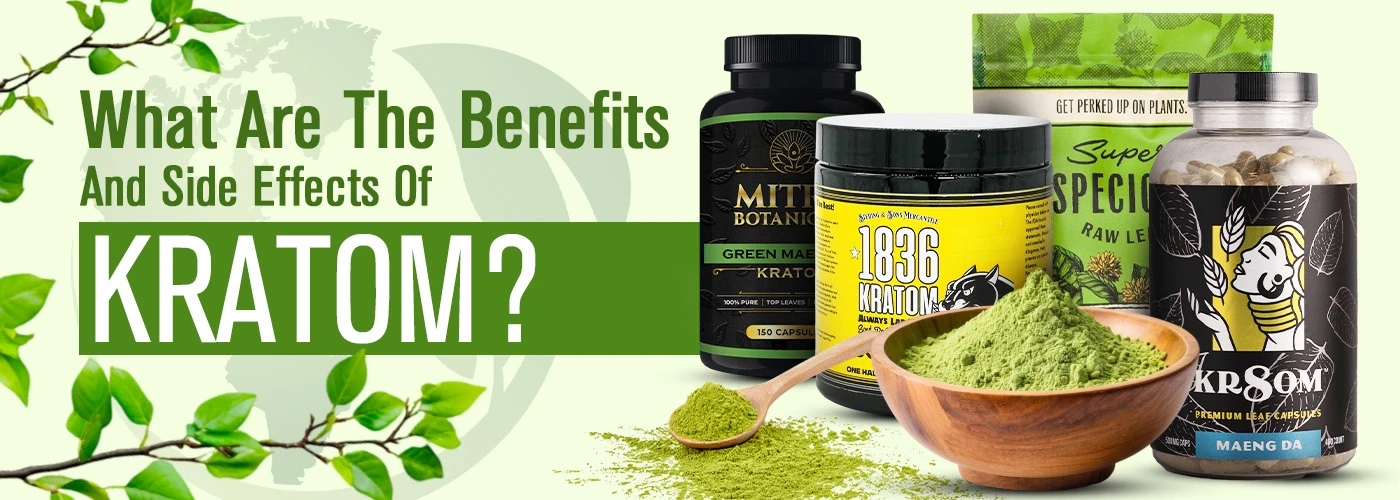Are you wondering – what are the benefits and side effects of kratom? Well, we seem to have read your mind. Today, we will talk about the perks of this powerful herb and also tell you about the possible drawbacks of going overboard.
So, without further ado, let us get right into it!
What is Kratom?
kratom is basically the leaves of a tropical tree scientifically called Mitragyna speciosa. It grows naturally in Thailand, Malaysia, and a few other locations in Southeast Asia. Before this herb went mainstream and became a household name in the West, farm workers in kratom’s origin countries used to chew the leaves of the plant to boost vitality and relieve themselves from discomfort. Farmers claimed kratom leaves allowed them to work harder for longer periods. Today, kratom has garnered fame as an energizer as well as a soother.
There are two main active ingredients in this herb: mitragynine and 7-hydroxymitragynine. Once ingested, kratom binds to opioid receptors in the body. It is probably how it helps reduce symptoms of physical discomfort. However, kratom is not an opioid. In fact, it is considered an alkaloid, which is a nitrogen-based compound found in plants.
Current Legal Status
Since this herb is a controlled substance in many countries, it is important that you know more about government regulations enforced in the USA.
Food and Drug Administration (FDA)
The U.S. FDA is yet to approve any over-the-counter prescription drugs containing kratom or its two main chemical components.
Drug Enforcement Administration (DEA)
The Controlled Substances Act does not list kratom as a controlled substance, but there are prohibitions or regulations in some states against the possession and use of this botanical.
The Benefits of Kratom
What are the benefits and side effects of kratom, you asked? Let us begin with the benefits. Very little research has been conducted on the health effects of this ancient herb. Still, there is some anecdotal evidence from kratom users, and some of these claims are already being studied.
Kratom for Discomfort
It is said that kratom might be effective in easing physical discomfort. It does so by attaching to opioid receptors in the body. After analyzing the properties of 7-hydroymitragynine, scientists found it to be 13 times more powerful than morphine.
While it targets opioid receptors like morphine and codeine, it is considered an atypical opioid. kratom deactivates specific signals, and it does so selectively. This behavior may explain the more tolerable side effects.
Kratom for Mood Improvement
kratom possibly has mood-enhancing effects. Early studies suggest kratom may be effective as an antidepressant and hunger suppressant. In an animal study, researchers found that this herb lowers corticosterone levels in mice. Increased levels of this hormone are just one of the main changes in brain chemicals that can be seen in depression.
In another study with rats, kratom supplementation suppressed hunger by inhabiting the hypothalamus. It is the part of the brain responsible for cravings and appetite. More research on humans is required to see if kratom has similar effects.
Kratom for Energy and Focus
Apart from its potential discomfort-relieving and mood-improving properties, kratom might be able to boost vitality and focus. This is because the alkaloids in the herb stimulate the release of adrenaline and other hormones in the body, resulting in increased alertness and concentration.
kratom can be especially helpful to those who wish to stay focused for extended periods, such as students and professionals.
The Side Effects of Kratom
Around two-thirds of over 2,500 adults in the USA reported no negative side effects after participating in a survey that involved kratom consumption and analyzing its disadvantages. However, overconsumption could lead to a few adverse effects, including:
- Nausea and decreased appetite
- Feeling sweaty
- Itchiness
- More frequent urination
- Dry mouth
- Fast heartbeat
- Liver damage
- Drowsiness
- Constipation
- Seizures
- Hallucinations
Not everyone takes kratom cleanly. They often mix it with other substances, and this act prevents experts from ascertaining whether these side effects are specific to kratom or not. Besides, there is also the matter of drug interactions. What we can say is this: side effects will be more likely if you take large doses, and that is why we always highlight the importance of starting low and going slow.
The Bottom Line
So, what are the benefits and side effects of kratom? This herb might be able to provide relief from physical discomfort and improve mood, but it is not devoid of a few side effects that might spring up if you consume more than required.
The best way to experience the true power of kratom is to avoid overconsumption. We also recommend consulting a physician before incorporating kratom into your daily routine. If your physician gives you the green light, you’re good to go! More often than not, an untested product is the real cause behind a regular user’s sickness. Make sure you do not pay for an untested product.
Check out our blog for frequent posts on the various aspects of kratom that you’re yet to discover. And get pure, safe, and lab-tested kratom products from some of the world’s best brands exclusively at Whole Earth Gifts.
FAQs
Q1. Can kratom be used to help with sleep issues?
A1. kratom may offer relaxation and promote better sleep due to its sedative effects at higher doses. However, excessive use may cause sleep disturbances.
Q2. Are there different types of kratom strains for various needs?
A2. Yes, kratom strains (red, green, white) serve different purposes. Red strains may aid relaxation, green strains boost mood, and white strains enhance energy and focus.
Q3. How long does it take for kratom to show its effects?
A3. kratom’s effects usually begin within 15 to 30 minutes of consumption and can last between 4 to 6 hours, depending on the dosage and strain.
Q4. Can kratom cause dependency or withdrawal symptoms?
A4. Yes, regular or high doses of kratom may lead to dependency. Withdrawal symptoms include irritability, agitation, and sleep disturbances, similar to mild opioid withdrawal symptoms.
Q5. What is the recommended way to consume kratom safely?
A5. Start with a low dose to gauge your body’s reaction. Gradually increase if needed. Avoid mixing it with other substances to reduce the risk of side effects.
Summary: What are the benefits and side effects of kratom? Read this to find the answer. Learn how it may aid discomfort relief, improve mood, and help you focus while understanding potential risks and proper usage.




